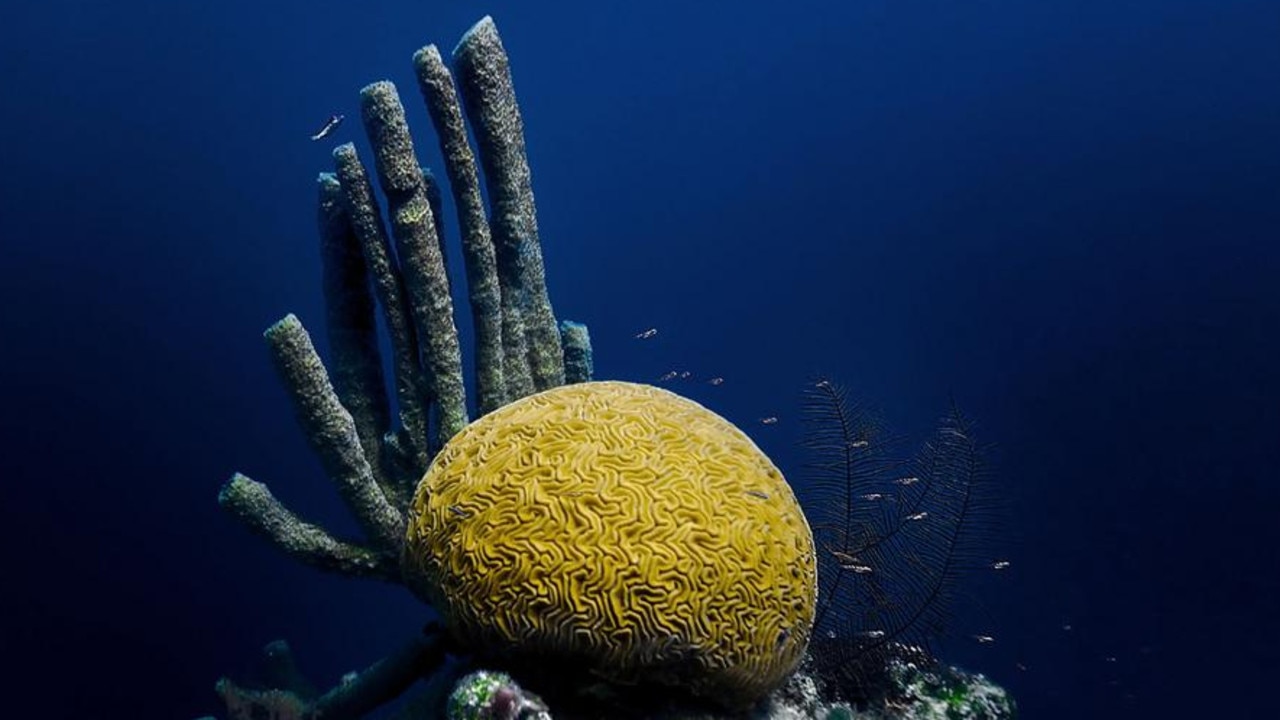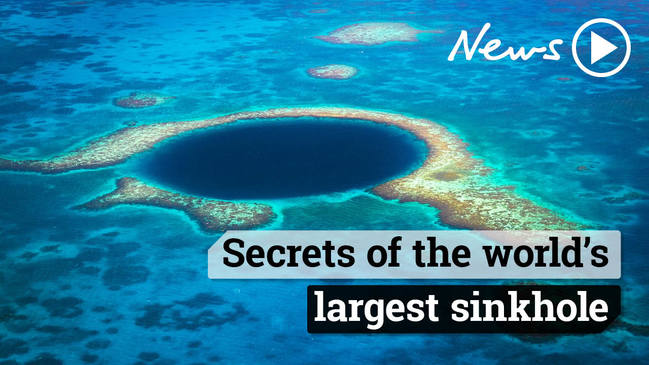Human rubbish found at the bottom of Belize’s Great Blue Hole
An expedition into a largely undiscovered ocean sinkhole has gone viral after plastic bottles and other rubbish were found at the bottom of the giant 124m deep hole

READING LEVEL: ORANGE
Divers have finally made it to the bottom of Belize’s iconic Great Blue Hole, but what they found was a troubling sight.
The Great Blue Hole is a giant marine sinkhole in the Caribbean off the coast of Belize in Central America.
Stretching 318m across and 124m deep, the large blue hole stands out from its surrounding reef when viewed from the sky.
The beautiful, almost perfectly circular hole has puzzled researchers since it was discovered, but not many people have been able to explore it because of its depth.
In 2018, billionaire Richard Branson funded an expedition to the bottom of the Great Blue Hole in order to create a 3D map of the sinkhole from the inside.
But when the crew from Aquatica Submarines started the long journey down, they were concerned with what they found – human rubbish in a part of the ocean largely unexplored.

THE JOURNEY DOWN
The first thing the crew saw was aquatic life: sea turtles, reef sharks and giant corals. But as they descended to 90m, signs of life started to vanish.
Erika Bergman, who was on the expedition, said a thick layer of toxic hydrogen sulfide stretched across the sinkhole, preventing oxygen from getting deeper.
“We found conches and conch shells and hermit crabs that had fallen into the hole and suffocated,” she said in an interview at the time.
But at the bottom of the Great Blue Hole was the most shocking discovery of all — human rubbish.
Branson’s team found a two-litre Coke bottle that had made its way 124 metres deep, as well as a lost GoPro camera full of someone’s holiday photos.

HISTORY OF THE GREAT BLUE HOLE
Not all of the team’s discoveries were quite so grim. They also found stalactites — a kind of icicle-shaped formation that usually hangs from the roof of a cave — which proved the Great Blue Hole was once a dry cave home to prehistoric life.
Scientists believe the cave formed during the last Ice age, which ended about 14,000 years ago. The cave flooded and collapsed as the Ice age ended and sea levels began to rise, leaving behind the Blue Hole we see today.
Researchers also predict it won’t be around forever. Waterfalls of sand tumble into the hole every day, slowly filling it up.

THE DANGERS OF CLIMATE CHANGE
The discoveries of the expedition went viral this week as “proof that humans are terrible.”
Reacting to the news online, many expressed shock at the troubling discoveries.
“Anyone want to explore the Blue Hole with me? Oh wait, humans have already ruined it,” one person wrote.
“Even a place where humans had never visited wasn’t safe from our trash. People are terrible,” added another.
Branson described the expedition as “one of the starkest reminders of the danger of climate change (he had) ever seen.”
“The Blue Hole is made of a complex system of caves that once formed on dry land. It is proof of how oceans can rise quickly and catastrophically,” he wrote at the time.
“The real monsters facing the ocean are climate change — and plastic. Sadly, we saw plastic bottles at the bottom of the hole, which is a real scourge of the ocean. We’ve all got to get rid of single-use plastic.”

POLL
GLOSSARY
- iconic: well-known, important or impressive and seems to be a symbol of something
- sinkhole: a hole in the ground caused by a collapse of the earth’s surface layer
- hydrogen sulfide: a flammable, poisonous gas
- suffocated: unable to breathe
- stalactites: a build-up of calcium carbonate that looks like an icicle hanging from the roof or sides of a cave
- starkest: the most grim
- catastrophically: occurring in a sudden and disastrous way
- scourge: something that brings great pain or suffering
- descended: went down
EXTRA READING
Great Barrier Reef gets thumbs up
China digs deep hole towards Earth’s centre
Nuclear wastewater plan explained
QUICK QUIZ
1. What is the Great Blue Hole?
2. How large is the Great Blue Hole?
3. At what depth did the expedition team find hydrogen sulfide?
4. What are two things the team found while exploring the Great Blue Hole?
5. What did Richard Branson describe as the “real monsters of the ocean”?
LISTEN TO THIS STORY
CLASSROOM ACTIVITIES
1. Draw the map
What do you think the map of the Great Blue Hole would look like? Use the information in the story to draw or create the map.
Time: allow 40 minutes to complete this activity
Curriculum Links: English, Science, Geography
2. Extension
Do you agree that the discovery of the Coke bottle and GoPro really is “proof that humans are terrible”? Write your answer. Remember to include lots of convincing points and examples to back up your opinion.
Time: allow 30 minutes to complete this activity
Curriculum Links: English, Science, Geography, Personal and Social Capability
VCOP ACTIVITY
To sum it up
After reading the article, use your comprehension skills to summarise in a maximum of three sentences what the article is about.
Think about:
What is the main topic or idea?
What is an important or interesting fact?
Who was involved (people or places)?
Use your VCOP skills to re-read your summary to make sure it is clear, specific and well punctuated.


